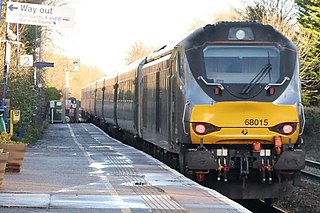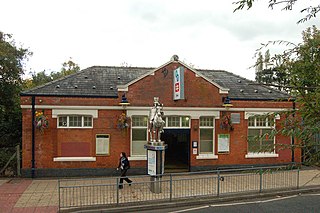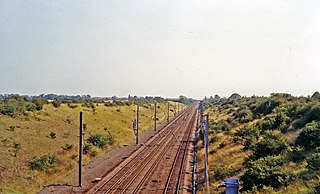
Chiltern Railways is a British train operating company that has operated the Chiltern Railways franchise since July 1996. Since 2009, it has been a subsidiary of Arriva UK Trains.

Railway signalling (BE), also called railroad signaling (AE), is a system used to control the movement of railway traffic. Trains move on fixed rails, making them uniquely susceptible to collision. This susceptibility is exacerbated by the enormous weight and inertia of a train, which makes it difficult to quickly stop when encountering an obstacle. In the UK, the Regulation of Railways Act 1889 introduced a series of requirements on matters such as the implementation of interlocked block signalling and other safety measures as a direct result of the Armagh rail disaster in that year.

The Quintinshill rail disaster was a multi-train rail crash which occurred on 22 May 1915 outside the Quintinshill signal box near Gretna Green in Dumfriesshire, Scotland. It resulted in the deaths of over 200 people and remains the worst rail disaster in British history.

Gerrards Cross railway station is a railway station in the town of Gerrards Cross in Buckinghamshire, England. It is on the Chiltern Main Line between Denham Golf Club and Seer Green and Jordans.

The Chiltern Main Line is a railway line which links London (Marylebone) and Birmingham, the United Kingdom's two largest cities, by a 112-mile (180 km) route via High Wycombe, Bicester, Banbury, Leamington Spa and Solihull.

High Wycombe railway station is a railway station in the town of High Wycombe, Buckinghamshire, England. The station is on the Chiltern Main Line between Beaconsfield and Saunderton stations. It is served by Chiltern Railways.

The British Rail Class 115 diesel multiple units were 41 high-density sets which operated the outer-suburban services from Marylebone usually to destinations such as High Wycombe, Aylesbury and Banbury which are on the Chiltern Main Line and Great Central Main Line. Sometimes, these sets used to operate 8- or 12-car-long expresses to Nottingham Victoria in the final years of the GCML. Coincidentally, Class 115 units operated services under Table 115 in the British Rail timetable.

Stourbridge Junction is one of two railway stations serving the town of Stourbridge, in the Metropolitan Borough of Dudley in the West Midlands, England. It lies on the Birmingham to Worcester via Kidderminster Line and is the junction for the Stourbridge Town Branch Line, said to be the shortest operational branch line in Europe. The other station serving Stourbridge is Stourbridge Town at the end of the branch line.

Princes Risborough station is a railway station on the Chiltern Main Line that serves the town of Princes Risborough in Buckinghamshire, England. It is operated by Chiltern Railways.

Beaconsfield railway station is a railway station in the town of Beaconsfield, Buckinghamshire, England. It is on the Chiltern Main Line between Seer Green and Jordans and High Wycombe stations. It is served by Chiltern Railways.

Seer Green and Jordans railway station is a railway station near the village of Seer Green in Buckinghamshire, England. It also serves the nearby village of Jordans. The station is on the Chiltern Main Line between Gerrards Cross and Beaconsfield. It is served by Chiltern Railways trains.

Dorridge railway station serves the large village of Dorridge in the West Midlands of England. The station is served by Chiltern Railways, who manage the station, and also by West Midlands Trains. It is situated 10+1⁄2 miles (16.9 km) south of Birmingham Snow Hill.

Olton railway station serves the Olton area of Solihull, in the West Midlands of England. The station is operated by West Midlands Trains. The entrance seen in the centre where the station's booking office is located leads into a tunnel which runs under the tracks providing an access staircase and lift to the island platform. The station also has a car park and bicycle racks.
The Connington South rail crash occurred on 5 March 1967 on the East Coast Main Line near the village of Conington, Huntingdonshire, England. Five passengers were killed and 18 were injured.

The Abbots Ripton rail disaster occurred on 21 January 1876 at Abbots Ripton, then in the county of Huntingdonshire, England, on the Great Northern Railway main line, previously thought to be exemplary for railway safety. In the accident, the Special Scotch Express train from Edinburgh to London was involved in a collision, during a blizzard, with a coal train. An express travelling in the other direction then ran into the wreckage. The initial accident was caused by:
The Great Western and Great Central Joint Railway was a railway built and operated jointly by the Great Western Railway (GWR) and Great Central Railway (GCR) between Northolt and Ashendon Junction. It was laid out as a trunk route with gentle curves and gradients and spacious track layouts. The two companies each needed approach railways at both ends of the line to connect their respective systems; these were built as part of a single project.
The Wrawby Junction rail crash was a train crash which occurred on 9 December 1983, at Wrawby Junction, near Barnetby station, North Lincolnshire, England.

The Knowle and Dorridge rail crash was a fatal rail crash that occurred at Dorridge railway station in the West Midlands, England, on 15 August 1963. Three people died in the crash after a signalman's error routed a small freight train into the path of an express passenger train which slowed but could not stop before colliding with it.
The Welwyn Tunnel rail crash took place in Welwyn North Tunnel, north of Welwyn station on the Great Northern Railway, on 9 June 1866. According to L T C Rolt, "from the point of view of damage to engines and rolling stock it was one of the most destructive in railway history."

On the evening of 26 December 1962, cold weather and snow in and around Crewe had caused points to become frozen and trains were being detained at signals. About midway between Winsford and Crewe, the 13:30 Glasgow Central to London Euston Mid-Day Scot, hauled by an English Electric type 4 diesel, D215, with 13 coaches and 500 passengers, was stopped at a signal but the driver found the telephone to Coppenhall Junction, the next signal box ahead, out of order. Seeing the next signal ahead he decided to proceed down towards it and use the telephone there, but too fast. In the darkness he failed to notice the 16:45 express from Liverpool Lime Street to Birmingham New Street, hauled by an electric locomotive with eight coaches with 300 passengers, standing on the line ahead and collided with it at about 20 mph (32 km/h).

















